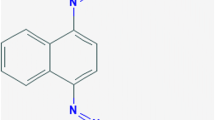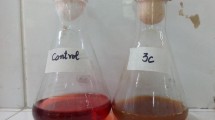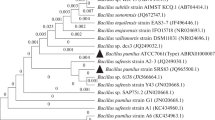Abstract
The complete biodegradation of azo dye, Fast Acid Red GR, was observed under microaerophilic conditions by Shewanella decolorationis S12. Although the highest decolorizing rate was measured under anaerobic condition and the highest biomass was obtained under aerobic condition, a further biodegradation of decolorizing products can only be achieved under microaerophilic conditions. Under microaerophilic conditions, S. decolorationis S12 could use a range of carbon sources for azo dye decolorization, including lactate, formate, glucose and sucrose, with lactate being the optimal carbon source. Sulfonated aromatic amines were not detected during the biotransformation of Fast Acid Red GR, while H2S formed. The decolorizing products, aniline, 1,4-diaminobenzene and 1-amino-2-naphthol, were followed by complete biodegradation through catechol and 4-aminobenzoic acid based on the analysis results of GC-MS and HPLC.






Similar content being viewed by others
References
Blümel S, Busse HJ, Stolz A, Kämpfer P (2001) Xenophilus azovorans gen. nov. sp. nov., a soil bacterium able to degrade azo dyes of the Orange II type. Int J Syst Evol Microbiol 51:1831–1837
Blümel S, Contzen M, Lutz M, Stolz A, Knackmuss H-J (1998) Isolation of a bacterial strain with the ability to utilize the sulfonated azo compound 4-carboxy-4′-sulfoazobenzene as the sole source of carbon and energy. Appl Environ Microbiol 64:2315–2317
Brown MA, DeVito SC (1993) Predicting azo dye toxicity. Crit Rev Environ Sci Technol 23:249–324
Chung KT, Cerniglia CE (1992) Mutagenicity of azo dyes: structure activity relationships. Mutat Res 77:201–220
Coughlin MF, Kinkle BK, Bishop PL (1999) Degradation of azo dyes containing aminonaphthol by Sphingomonas sp. strain 1CX. Ind Microbiol Biotechnol 23:341–346
Glässer A, Liebelt U, Hempel DC (1992) Design of a two-stage process for total degradation of azo dyes. DECHEMA Biotechnol Conf 5B:1085–1088
Gralnick JA, Vali H, Lies DP, Newman DK (2006) Extracellular respiration of dimethyl sulfoxide by Shewanella oneidensis strain MR-1. Proc Natl Acad Sci USA 103:4669–4674
Heidelberg JF, Paulsen IT, Nelson KE, Gaidos EJ, Nelson WC, Read TD, Eisen JA, Seshadri R, Ward N, Methe B, Clayton RA, Meyer T, Tsapin A, Scott J, Beanan M, Brinkac L, Daugherty S, DeBoy RT, Dodson RJ, Durkin AS, Haft DH, Kolonay JF, Madupu R, Peterson JD, Umayam LA, White O, Wolf AM, Vamathevan J, Weidman J, Impraim M, Lee K, Berry K, Lee C, Mueller J, Khouri H, Gill J, Utterback TR, McDonald LA, Feldblyum TV, Smith HO, Venter JC, Nealson KH, Fraser CM (2002) Genome sequence of the dissimilatory metal ion-reducing bacterium Shewanella oneidensis. Nat biotech 20:1118–1123
Hong Y, Chen X, Guo J, Xu Z, Xu M, Sun G (2007) Effects of electron donors and acceptors on anaerobic reduction of azo dyes by Shewanella decolorationis S12. Appl Microbiol Biotech 74:230–238
Hu TL (1994) Decolorization of reactive azo dye by transformation with Pseudomonas luteola. Biores Technol 49:47–51
Keck A, Klein J, Kudlich M, Stolz A, Knackmuss HJ, Mattes R (1997) Reduction of azo dyes by redox mediators originating in the naphthalenesulfonic acid degradation pathway of Sphingomonas sp. strain BN6. Appl Environ Microbiol 63:3684–3690
Kudlich M, Bishop P, Knackmuss H-J, Stolz A (1996) Synchronous anaerobic and aerobic degradation of the sulfonated azo dye Mordant Yellow 3 by immobilized cells from a naphthalenesulfonate-degrading mixed culture. Appl Microbiol Biotechnol 46:597–603
Kumar K, Devi SS, Krishnamurthi K, Gampawar S, Mishra N, Pandya GH, Chakrabarti T (2006) Decolorisation, biodegradation and detoxification of benzidine based azo dye. Bioresour Technol 97:407–413
Krooneman J, Wieringa EBA, Moore ERB, Gerritse J, Prins RA, Gottschal JC (1996) Isolation of Alcaligenes sp. strain L6 at low oxygen concentration and degradation of 3-chlorobenzoate via a pathway not involving (chloro) catechols. Appl Environ Microbiol 62:2427–2434
Nealson KH, Scott J (2003) Ecophysiology of the genus Shewanella. In: Dworkin M (ed) The Prokaryotes, vol. 2004. Springer, New York
Olsen RH, Kukor JJ, Kaphammer B (1994) A novel toluene-3-monooxygenase pathway cloned from Pseudomonas pickettii PKO1. J Bacteriol 176:3749–3756
Pearce CI, Lloyd JR, Guthrie JT (2003) The removal of colour from textile wastewater using whole bacterial cells: a review. Dyes Pigm 58:179–196
Pearce CI, Christie R, Boothman C, von Canstein H, Guthrie JT, Lloyd JR (2006) Reactive azo dye reduction by Shewanella strain J18 143. Biotechnol Bioeng 95:692–703
Peres CM, Naveau H, Agathos SN (1998) Biodegradation of nitrobenzene by its simultaneous reduction into aniline and mineralization of the aniline formed. Appl Microbiol Biotechnol 49:343–349
Sambrook J, Fritsch EF, Maniatis T (1989) Molecular cloning: a laboratory manual, 2nd edn. Cold Spring Harbor Laboratory, Cold Spring Harbor, NY
Stolz A (1999) Degradation of substituted naphthalenesulfonic acids by Sphingomonas xenophaga BN6. J Ind Microbiol Biotechnol 23:391–399
Stolz A (2001) Basic and applied aspects in the microbial degradation of azo dyes. Appl Microbiol Biotechnol 56:69–80
Tan NC, van Leeuwen A, van Voorthuizen EM, Slenders P, Prenafeta-Boldú FX, Temmink H, Lettinga G, Field JA (2005) Fate and biodegradability of sulfonated aromatic amines. Biodegradation 16:527–537
Tiedje JM (2002) Shewanella—the environmentally versatile genomes. Nat Biotech 20:1903–1904
Venkateswaran K, Moser DP, Dollhopf ME et al (1999) Polyphasic taxonomy of the genus Shewanella and description of Shewanella oneidensis sp. nov. Int J Syst Bacteriol 49:705–724
Viliesid F, Lilly MD (1992) Influence of dissolved oxygen tension on the synthesis of catechol 1, 2-dioxygenase by Pseudomonas putida. Enzyme Microb Technol 14:561–565
Xu M, Guo J, Cen Y, Zhong Xn, Cao W, Sun G (2005) Shewanella decolorationis sp. nov., decolorizing bacterium isolated from activated sludge of a waste-water treatment plant. Int J Syst Evol Microbiol 55:363–368
Xu M, Guo J, Zeng G, Zhong X, Sun G (2006) Decolorization of Anthraquinone Dye by Shewanella decolorationis S12. Appl Microbiol Biotech 71:246–251
Xu M, Guo J, Kong X, Chen X, Sun G (2007) Fe(III)—enhanced Azo Reduction by Shewanella decolorationis S12. Appl Microbiol Biotech 74:1342–1349
Yatome C, Matsufuru H, Taguchi T, Ogawa T (1993) Degradation of 4’-dimethylaminoazobenzene-2-carboxylic acid by Pseudomonas stutzeri. Appl Microbiol Biotechnol 39:778–781
Zhou N, Jenkins A, Chan Kwo Chion CKN, Leak DJ (1999) The alkene monooxygenase from Xanthobacter strain Py2 is closely related to aromatic monooxygenases and catalyzes aromatic monohydroxylation of benzene, toluene, and phenol. Appl Environ Microbiol 65:1589–1595
Zissi U, Lyberatos G, Pavlou S (1997) Biodegradation of p-amino-azobenzene by Bacillus subtilis under aerobic conditions. J Ind Microbiol Biotechnol 19:49–55
Acknowledgement
This research was supported by the Chinese National Natural Science Foundation (3050009), Guangdong Provincial Key Programs for Science and Technology Development (05100365), Guangdong Provincial Natural Science Foundation (No.015017), Guangdong Provincial Programs for Science and Technology Development (2006B36703001) and Guangzhou Programs for Science and Technology Development (2006Z3-E0461).
Author information
Authors and Affiliations
Corresponding author
Rights and permissions
About this article
Cite this article
Xu, M., Guo, J. & Sun, G. Biodegradation of textile azo dye by Shewanella decolorationis S12 under microaerophilic conditions. Appl Microbiol Biotechnol 76, 719–726 (2007). https://doi.org/10.1007/s00253-007-1032-7
Received:
Revised:
Accepted:
Published:
Issue Date:
DOI: https://doi.org/10.1007/s00253-007-1032-7




